Use this 3 days in Rome itinerary to plan an epic trip to the eternal city of Rome during your Italy trip. Know where to stay, what to do, how to get around, useful tips that’ll enable you to travel smarter, and how to spend each day to make the most of your time!
Rome…
a city where the past seamlessly intertwines with the present, where every cobblestone whispers tales of emperors and gladiators, where every alleyway holds a secret, where every piazza beckons you to stay just a while longer, and where the food makes you drool!
If you’re someone who enjoys history, art, architecture, or food, then Rome is absolutely and totally for you. And even if you don’t, you will still be in awe of the sights in this city.
- When to Go to Rome
- Where to Stay in Rome
- Day 0: Giardino Degli Aranci OR Food Tour/Cooking Class
- Day 1: Colosseum, Roman Forum, Capitoline Hill and Trastevere
- Day 2: Vatican City and Centro Storico
- Day 3: Palazzo Colonna and Villa Borghese
- How to Reach the Rome City from the Airport
- How to Get Around Rome
- Is it worth buying any Rome City Passes?
- Other Tips for Visiting Rome
Before we get into the 3 days in Rome itinerary, let’s first discuss some essential things you must know!
When to Go to Rome
The best time to visit Rome is April to June (spring) or September to October (fall), when the weather is pleasant and it isn’t very crowded. The city’s iconic landmarks, such as the Colosseum and the Vatican, are more enjoyable without the summer heat or the winter chill.
However, if you do go in other periods, go with your expectations set. Winter (November–March) will be cold with shorter days, but prices will be low and the crowds will be minimal.
If you go during the summer (July–August), you’ll find Rome to be lively, but that comes at the cost of high temperatures, crowds, and high costs. This is the time we were in Rome! Prices sure were high, but we loved the vibe! If you’re travelling during this period, then ensure you book your accommodation six months or more in advance.
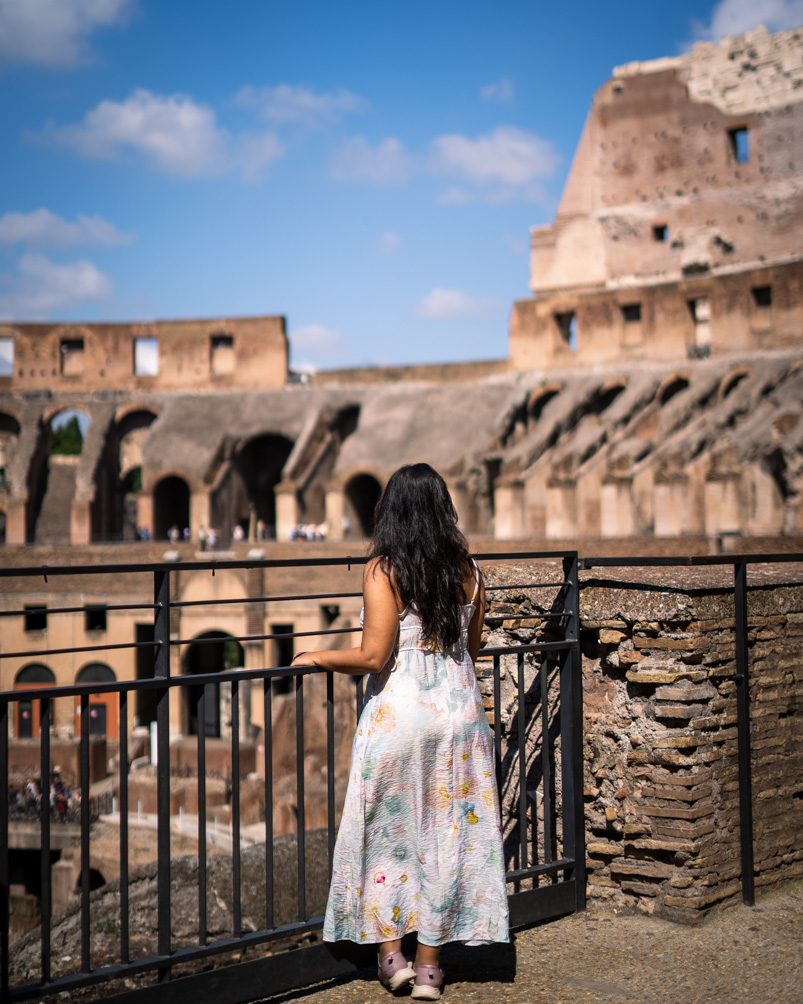
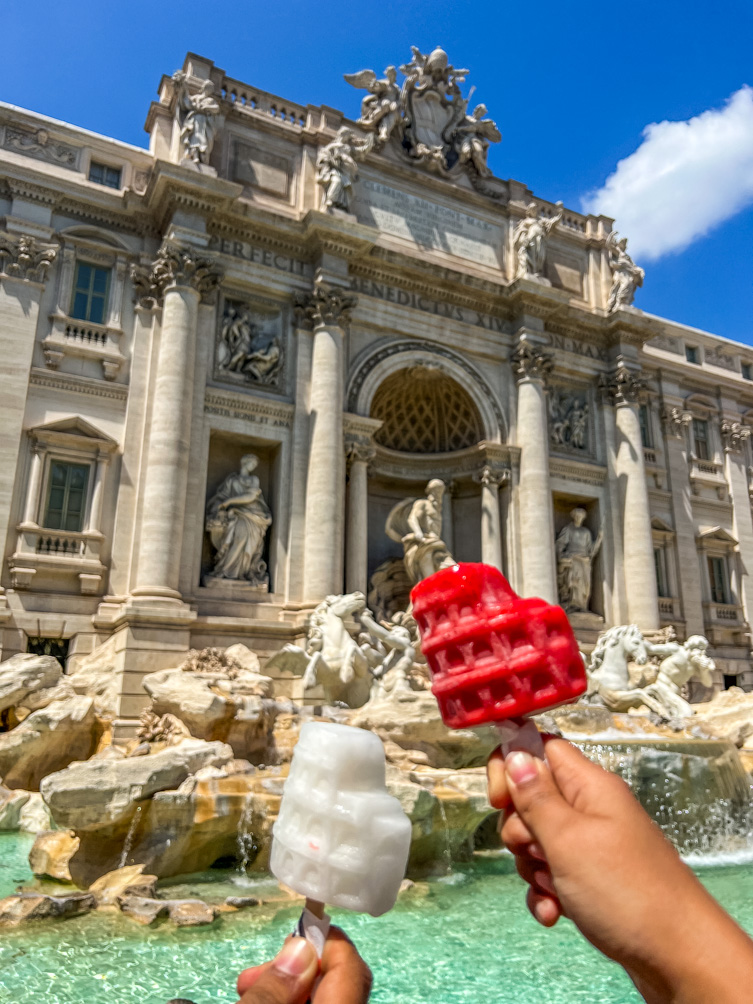
Where to Stay in Rome
Selecting the right neighbourhood can have a huge impact on your Roman holiday. These are the areas to consider:
The Historic Centre (Centro Storico): The centre offers a quintessential experience, placing you near iconic sites like the Pantheon and Trevi Fountain. You’ll be at the best location possible if you stay near these sights, and you’ll hardly need to use public transport, but prices will be high.
Trastevere: Trastevere is a great alternative if you’re looking for a vibrant, bohemian atmosphere with great food options. It is a bit away from the main sights, but they’re not too far, and you’ll surely love the lively evenings in this area.
The one area you should avoid is around Roma Termini, the main train station in Rome. It is not particularly safe, and I have heard horror stories of how people moved from there after spending just one night there.
Hotel Options in Rome
Here are a few options for mid-range stays with great ratings in excellent locations. Each one of them has AC, private bathrooms, free Wi-Fi, and soundproofing.
- Domer Trevi (in Centro, near Trevi Fountain)
- Navona Jacuzzi Rooms (in Centro, near Piazza Navona)
- Feronia Guest House (in Centro, near Pantheon)
- B&B Suites Tastrevere (in Trastevere)
Where We Stayed
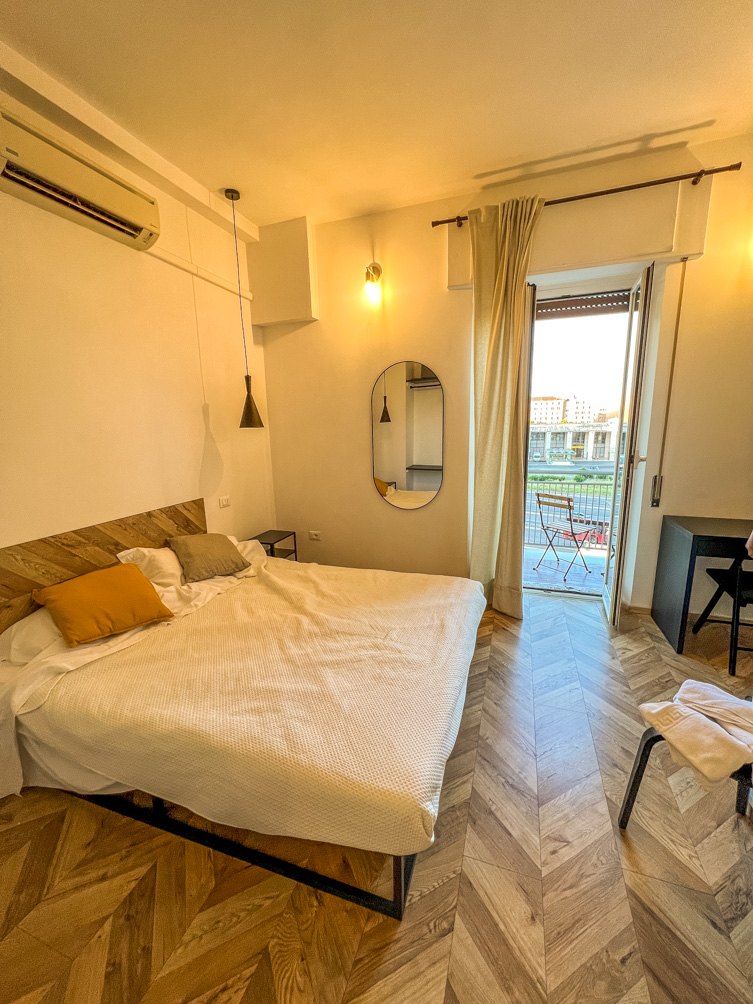
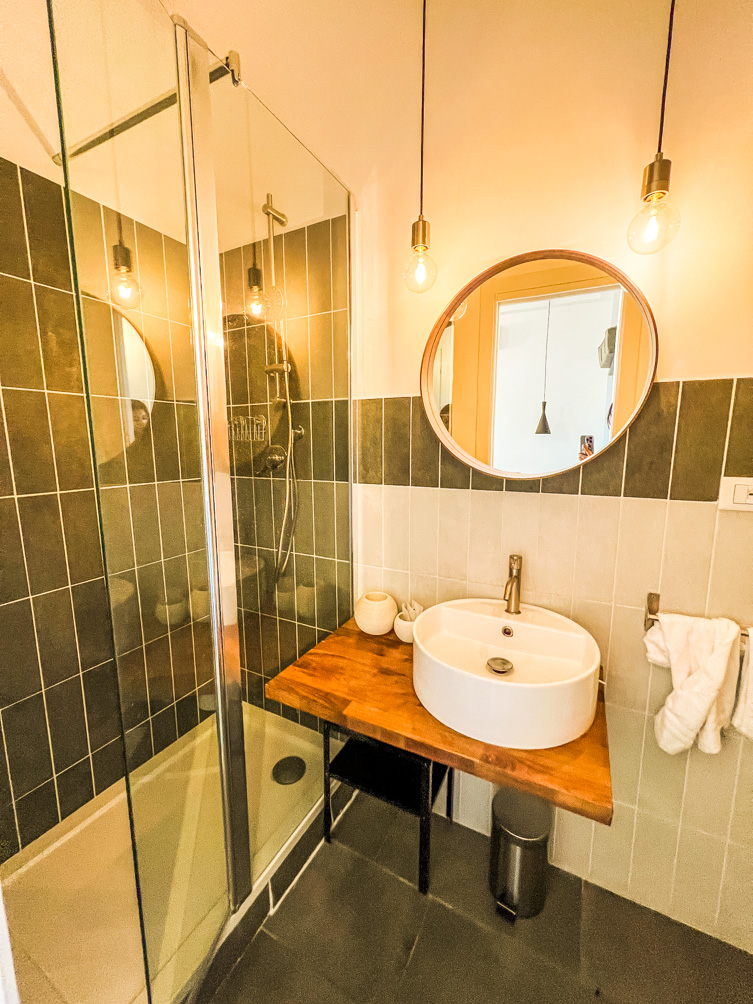
We stayed at CasaValentina in Aventino, Rome. It was a bit away from the centre, but it fit our budget in the summer months and had an excellent connection to public transport. The bus stop, the metro station, and the train station were just a few minutes walk. We had a clean and aesthetic room, a private bathroom, a balcony, and air conditioning. The stay also had free coffee and snacks (excellent for a quick breakfast early in the morning) in the common area. The wifi was great too! We wished there had been some restaurants and grocery stores around, but all in all, it was great value for money in an expensive city like Rome.
See prices and booking options for CasaValentina
3 days in Rome itinerary
This is an interactive map with all the spots mentioned in the itinerary already marked on it. Attractions for each day are denoted by a separate colour, and recommended eateries are also marked. You can expand this map for a closer look and even add the spots to your own Google Maps for future reference.
Day 0: Giardino Degli Aranci OR Food Tour/Cooking Class
Since the Rome itinerary given below requires a full 3 days, I’m assuming you will arrive a day before to settle in your hotel.
On this day, you can watch a gorgeous sunset at Giardino Degli Aranci, or the Garden of Oranges. It is a garden with bitter orange trees, and it offers a breathtaking perspective of Rome, particularly St. Peter’s Basilica. It is free to enter and popular with locals.
Otherwise, if you’re a foodie hoping to understand more about the divine Italian cuisine, then join one of the handpicked food tours or cooking classes given below.
Day 1: Colosseum, Roman Forum, Capitoline Hill and Trastevere
Rome Day 1 Walking Route Map
Morning: Colosseum
Timing: Varies all year. Check timings and updated information here
Cost: €18-24
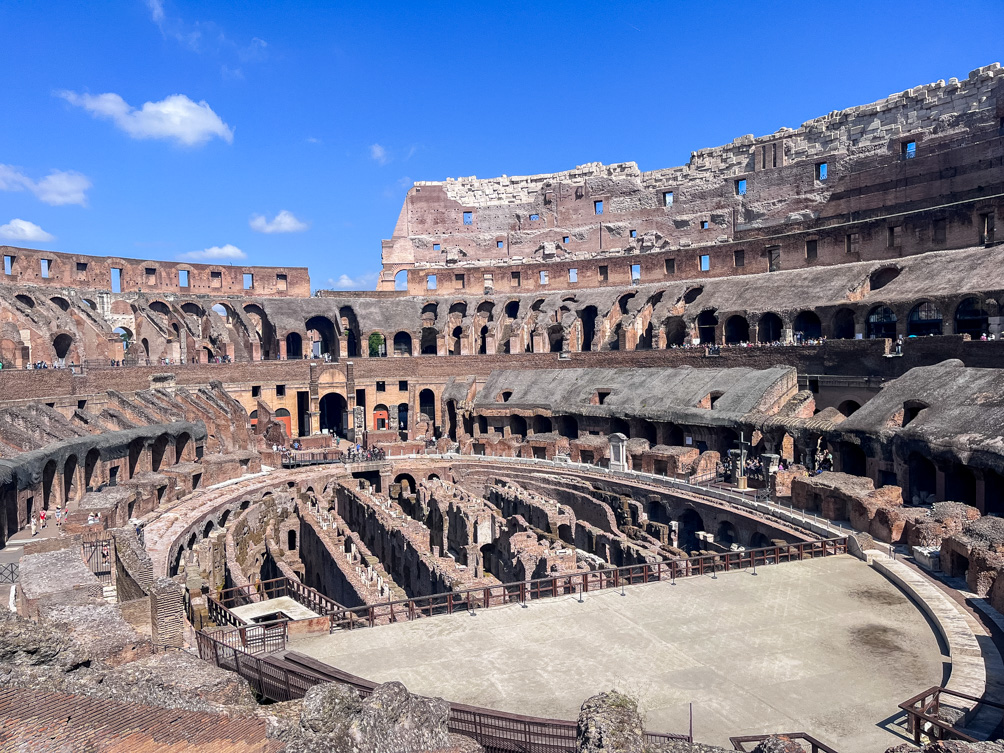
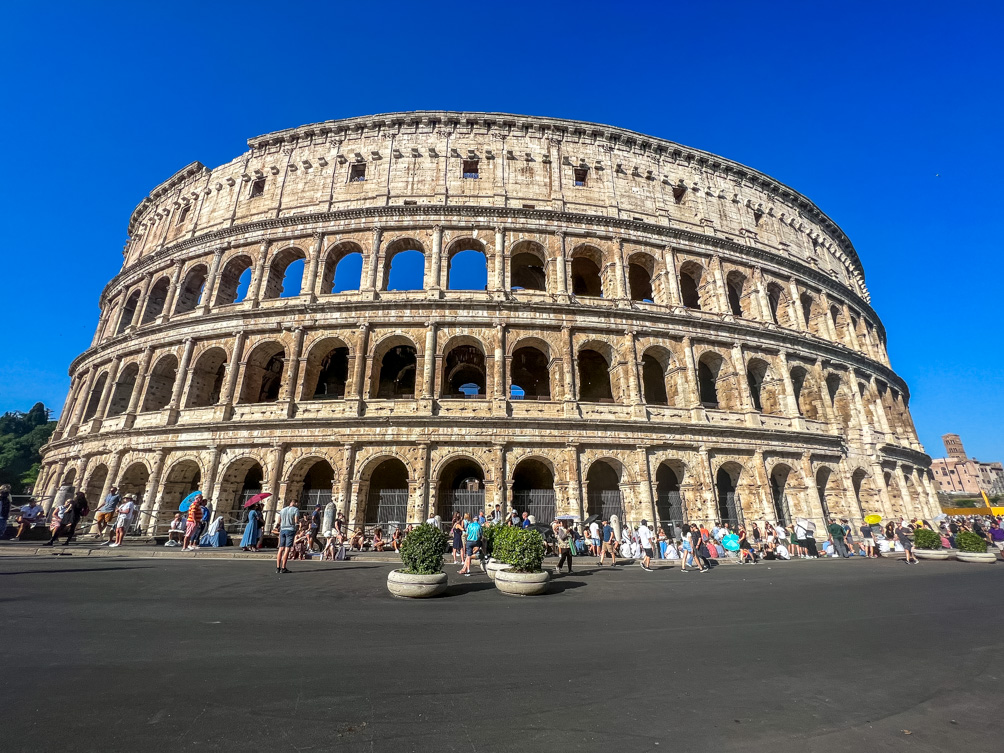
Admire the magnificence of the Colosseum, where stories of gladiatorial combat come to life. Constructed between the years 72 and 80 AD, the Colosseum has a capacity to hold 80,000 spectators for public events like gladiatorial matches. A must-see for its sheer grandeur, it reflects the engineering prowess and historical might of ancient Rome. It is one of the seven wonders of the world, and hence, it can’t be missed on your first visit to Rome.
Tips for visiting the Colosseum
- It is best to go to the Colosseum at opening time, which varies throughout the year, so check timings for your dates.
- To tour the Colosseum without having to buy an additional guided tour or audio guide, listen to the Rick Steves Audio Europe tour ‘The Colosseum’ but you won’t be able to ask your questions and have to find your way around yourself.
- Buying a ticket to the Colosseum also gives you free entry to the Roman Forum and Palatine Hill. So don’t lose your ticket.
- The “Sperone Valadier,” which is next to the Arch of Constantine, is where you can enter the Colosseum.
- Buy the tickets beforehand so that you can visit the Colosseum at your preferred time without having to buy tickets in black. Yes, people sell exorbitantly priced tickets near the Colosseum because it can be near impossible to buy tickets on the day of and because buying the tickets on the official website can be highly problematic sometimes. So I highly recommend buying the ticket through this website. Or better yet, do a well-rated guided tour to make the most of your visit to this world wonder. Check the availability of the tour below.
Brunch
You’re probably going to be famished after a few hours at the Colosseum, especially if you arrive without eating a heavy breakfast. In that case, you can head to one of the restaurants nearby (about a 200-metre walk). These restaurants will have a view of the Colosseum, but beware that these will be restaurants catering to tourists.
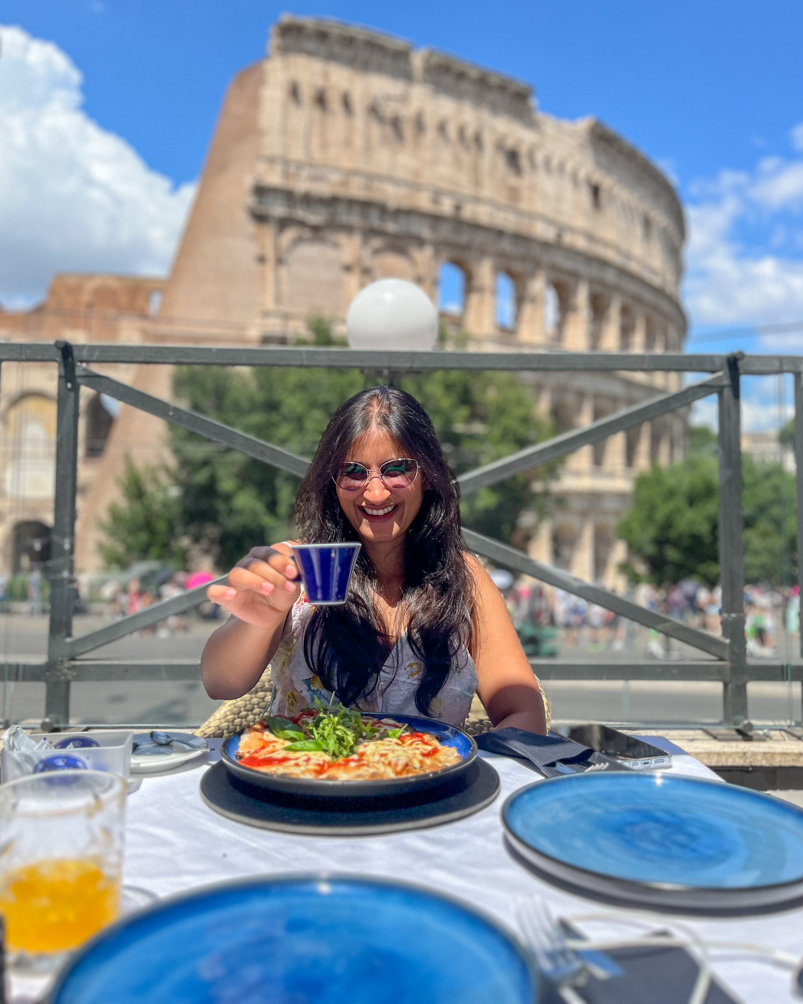
Options:
- Ristoro Della Salute
- Ristorante Pizza Forum Roma
- Royal Art Cafè Roma: This is where we ate!! The food was enjoyable, and the view was fantastic.
- Il salotto del Colosseo
Afternoon: The Roman Forum
Walk about 400 metres to the Roman Forum.
The Roman Forum, which dates to the 7th century BC, is situated next to the Colosseum. The social, economic, political, and religious centre of the incredibly large Roman Empire was located on this 5-acre plot of land. With its strewn columns and the remnants of palaces and temples, it is now a treasure trove of archaeological discoveries. This is where Marc Antony uttered the well-known line, “Friends, Romans, countrymen, lend me your ears,” in Shakespeare’s words. Even a temple honouring Julius Caesar exists. Walking around the Roman Forum was, to us, more interesting than even the Colosseum.
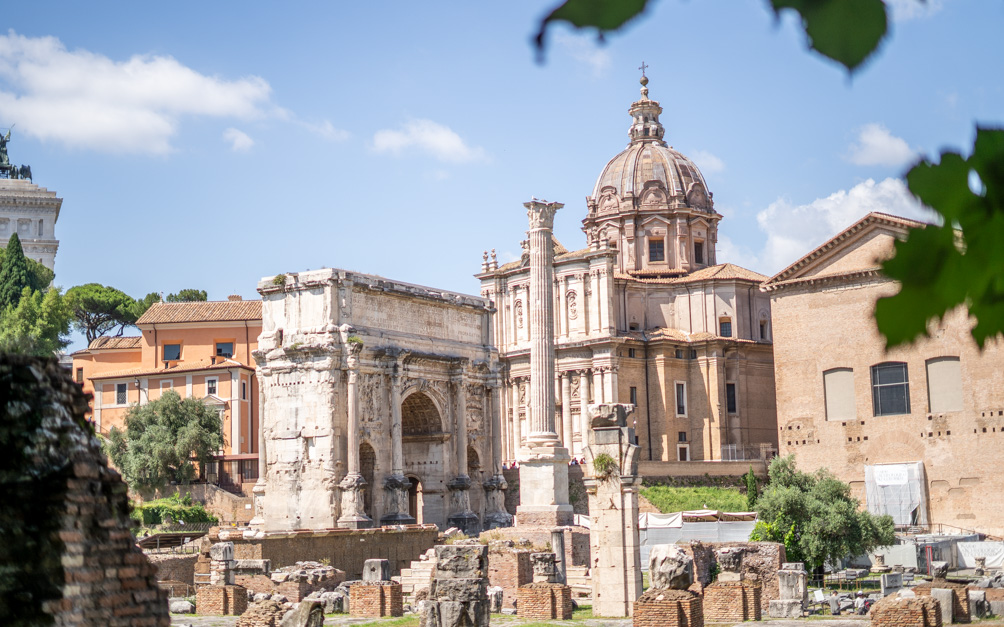
Tip: To learn more about the Roman Forum and make sense of the ruins, download and listen to Rick Steve’s Audio Europe guide ‘The Roman Forum’ while walking around the area. If you’re following this audio tour, first walk up Palatine Hill, ‘where Rome was born’ and then continue with the audio tour.
Afternoon: Capitoline Hill
From the Roman Forum, exit at the far end and go up 200 metres on the Capitoline hill towards the Capitoline museums. Don’t forget to look down at the Roman Forum when you’re up the hill. The view is amazing.
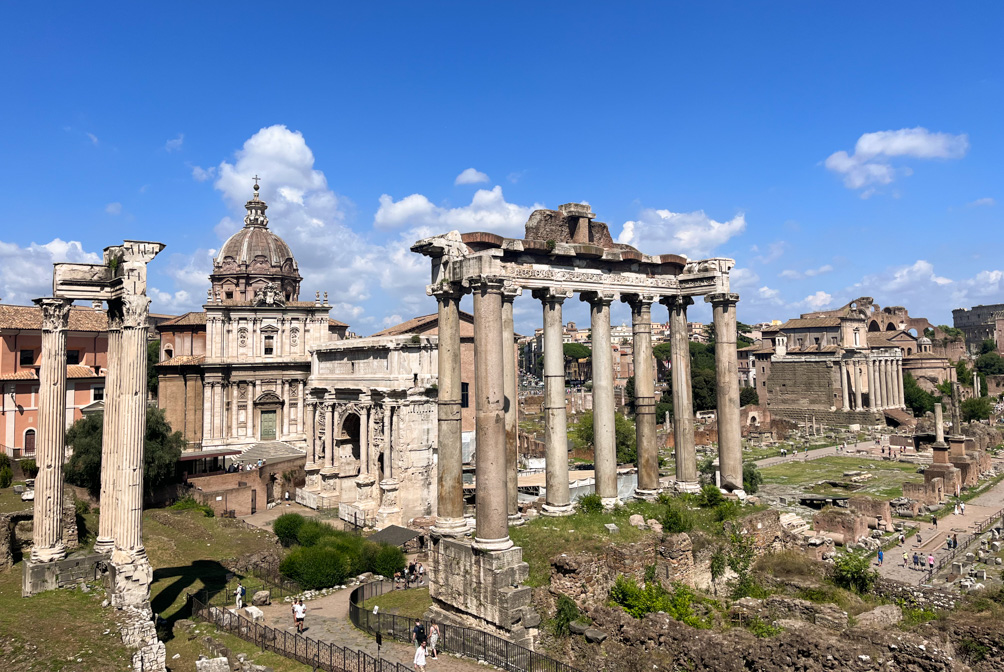
The Capitoline Museum is the world’s oldest public museum. The history of the museums dates back to 1471, when Pope Sixtus IV donated important ancient bronzes to the people of Rome and located them here. Since then, the museum’s collection has grown to include a large number of ancient Roman statues, a collection of medieval and Renaissance art, and many other items.
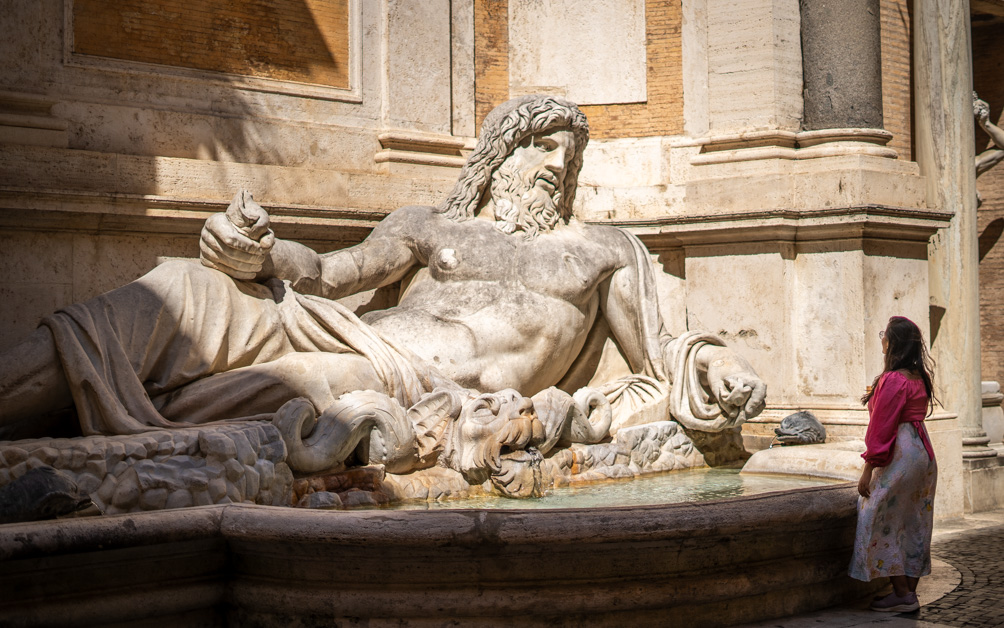
We checked out the museum because it was free that day, being the first Sunday of the month, and we enjoyed it. However, since you’re going to be seeing so many more superb museums, go inside this one only if you’re especially interested.
But do check out the architecture of the museum from the outside and the piazza with the statue of Marcus Aurelius in the centre (a copy of the original is inside the museum). The plan for the piazza was conceived by Michelangelo, and it is a sight itself.
Evening: Monument to Victor Emmanuel II
Walk 180 metres to the Victor Emmanuel II Monument. The Victor Emanuelle II Monument honours the first king of a united Italy and was finished in 1935. With its imposing structure and columns and statues, it is a visual celebration of the identity of the country. This is another attraction you need not enter but just see from the outside!
Evening: Largo di Torre Argentina
If you’re tired, head back to your hotel for a bit before venturing out again. If not, walk 600 metres to Largo di Torre Argentina to see where Julius Caeser was assassinated. Pay and go in if you’d like, or just see the archaeological site from the outside like we did.
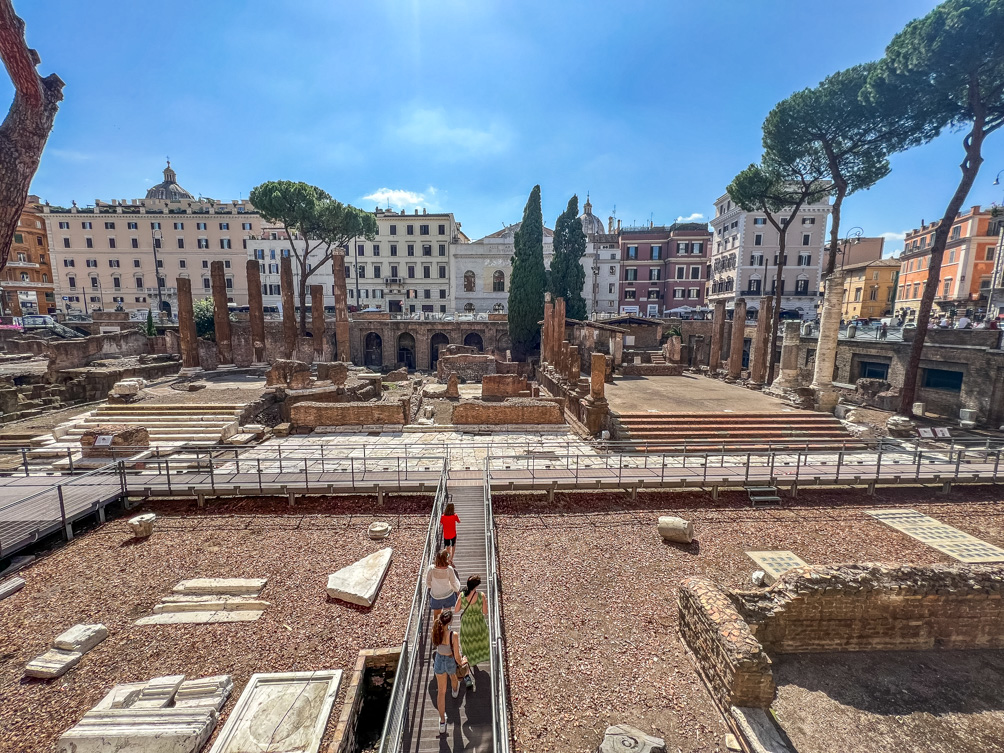
Finally, I’d recommend heading to Trastevere for an evening saunter since it’s very lively and you’ll surely want to visit again on another day. However, if you don’t have any energy left, alternatively grab dinner near your hotel and call it a night.
Late Evening: Ponte Sisto and Trastevere
Get to Ponte Sisto around sunset. Ponte Sisto is a pedestrian bridge with wonderful views over the River Tiber. Watch the perfect sunset here, overlooking St. Peter’s Basilica. Later, cross the river to the bohemian allure of the area called Trastevere.
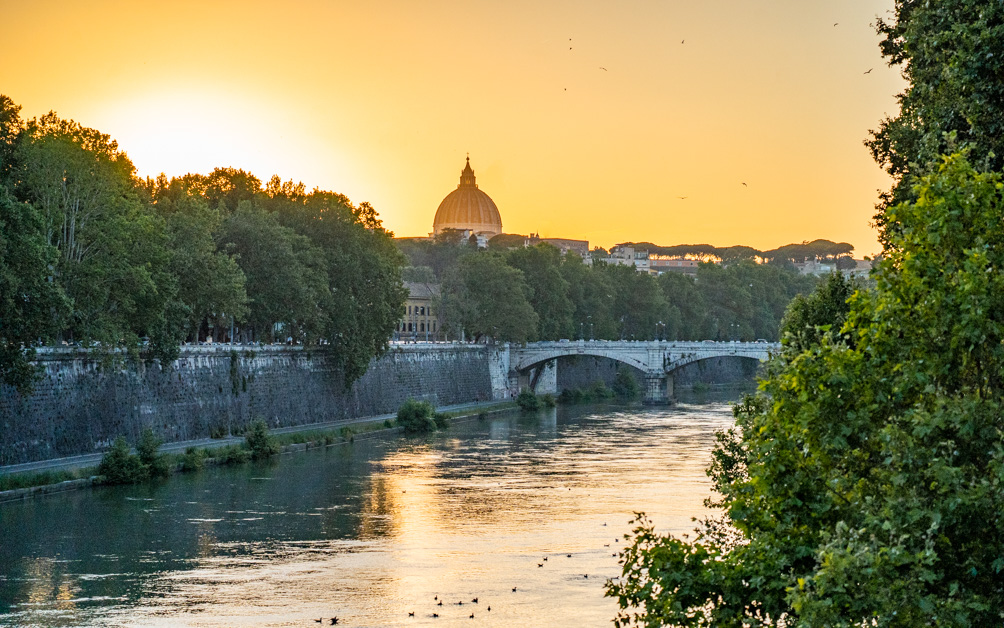
Trastevere’s charm lies not only in its narrow cobblestone streets with vibrant buildings but also in its lively bohemian spirit. The area is a cultural melting pot with vibrant nightlife and an array of authentic eateries. Wander around and discover hidden piazzas, indulge in local trattorias serving up Roman delights, and feel the heartbeat of Rome’s artistic and laid-back soul.
Dinner
Have dinner at Tonarello, a casual eatery specialising in pasta, meatballs, and other simple Roman dishes. Plus, there is patio seating and an acoustic guitar. There is usually a huge queue that moves quickly since Tonarello has a lot of seating space. Anyone who has had a meal at Tonarello will tell you that the queue is worth it.
Day 2: Vatican City and Centro Storico
Today, you’ll visit Vatican City. It is an independent city-state, the smallest country in the world, found within the city of Rome (yes, within). It is the headquarters of the Roman Catholic Church and is ruled by the Pope. Why should you visit? Well, this is a place where art and faith converge, and trust me, you’ll be blown away by its beauty.
Early Morning: St. Peters Basilica
Timings: 08.00 a.m. – 07.00 p.m. The final entry is at 05.00 p.m. It is closed on Sundays, except the last Sunday of each month. See here for the latest timings.
Cost: Free
Consecrated in 1626, St. Peter’s Basilica is the largest church in the world and is widely believed to be the final resting place of Saint Peter himself. The church is a masterpiece of Renaissance architecture. The church was designed by artists like Raphael, Bernini, and others, but the dome was designed exclusively by Michelangelo. Additionally, Pieta, the well-known sculpture by Michelangelo, is housed here.
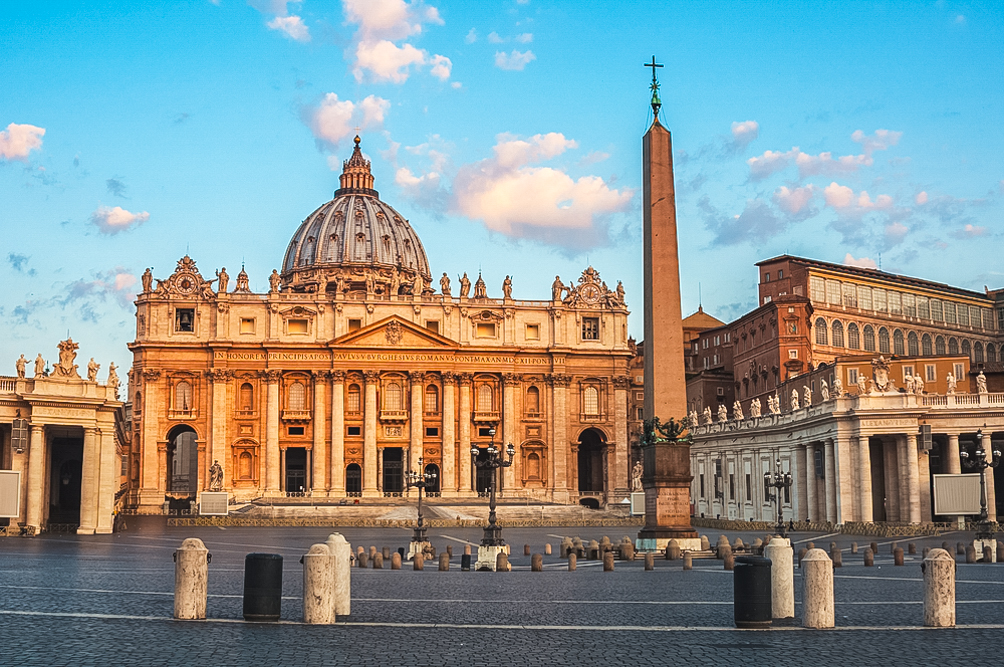
Although the Vatican is a country, you won’t even realise it when you enter it because there is no boundary wall or security. You can see St. Peter’s Square any time you want. However, to enter St. Peter’s Basilica, you will have to queue up for security, and usually, this queue is very long. Therefore, it is best to go here first thing in the morning, though I have heard that sometimes it can get empty at noon or late in the evening, but it all depends on your luck.
Additionally, you can climb the basilica‘s dome for breathtaking views of the Vatican. It costs €8 if you take the stairs or €10 if you take the elevator. Unfortunately, you can’t purchase the ticket beforehand, only at the ticket counter. The queue for entry to the dome is always long.
Morning: Vatican Museums
Timings: Entry starts at 8 a.m. Closing time charges per season, and Sundays are closed except the last Sunday of the month. Check the timings here.
Ticket Cost: €20
Ticket Purchase: Buy your ticket here.
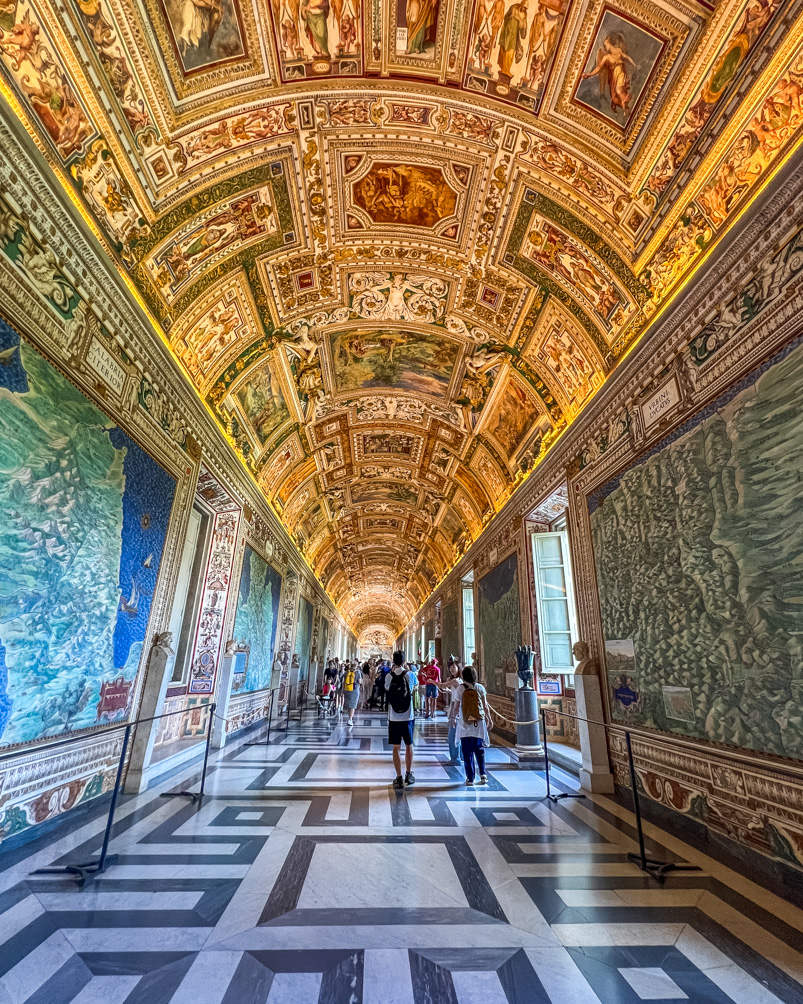
Founded in the early 16th century, the Vatican Museums are a set of 26 museums spanning 14 km that house an unparalleled collection of art (over 70,000 pieces) accumulated by various popes over the centuries. Don’t worry, you don’t have to visit 26 museums but rather pass through several galleries, as the museums are all attached.
The museums are fantastic. The Sistine Chapel, adorned by Michelangelo’s frescoes, is the crowning jewel. The Sistine Chapel technically resides in the Apostolic Palace, home of the pope, rather than the Vatican Museums. However, the only way to see the Sistine Chapel is through the Vatican Museums, and all tickets to this site allow you to visit the Sistine Chapel as well.
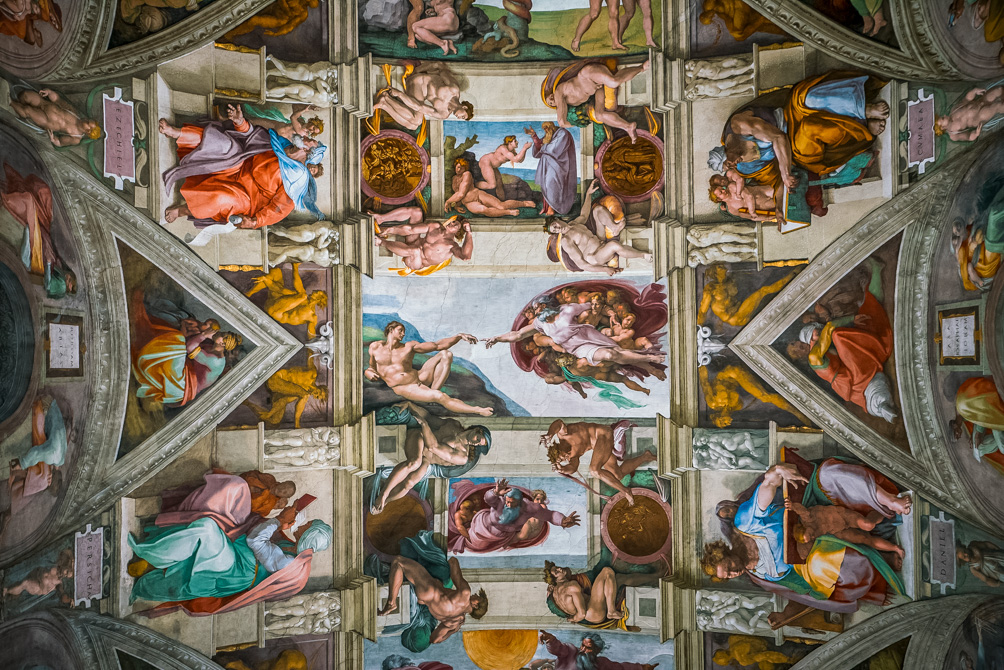
Tips to make your Vatican City visit a breeze
- The best way to see the Vatican is on a tour. Not only can you get into St. Peter’s Basilica early, but you can also avoid the long queue at the Vatican Museums. This is the way we did it! It’s not cheap, but I highly recommend it for saving tonnes of time by not queuing up and seeing the highlights in the Vatican Museum. It is also the best way to go up the dome for a limited time. Here are some tours we recommend.
Early-Morning Vatican Museums and Sistine Chapel Tour: Start with the Vatican Museums at opening time and enter St. Peter’s Basilica via a secret passageway. Usually, you need to queue up twice to see both the sights—the Vatican Museums and St. Peter’s Basilica—and this tour is the only way to avoid it and thereby save tonnes of time. This secret passageway entry reduces your walking distance greatly! Do not take this tour on a Wednesday, as the secret passageway may be closed.
Vatican Museums and St. Peter’s Tour with Dome Climb: Climb the dome first before seeing St. Peter’s Basilica, then finally head to the Vatican Museums and get in without lining up.
- If you’d like to stop and look at particular things for a long time or walk at your own pace, then tours might not be for you. In that case, here’s what I would recommend.
Visit St. Peter’s Basilica at opening time. Queue up a bit before opening time so you’re one of the first ones to enter. You do not need to buy a ticket for this, as it is free. Just download and listen to the Rick Steves Audio Tour ‘St. Peter’s Basilica’ and walk at your own pace, admiring the most beautiful church on this planet.
For the Vatican Museums, buy a skip-the-line ticket. The queue outside the museums is the biggest we have ever seen in our lives (over a kilometre long), so it is highly recommended to a get this skip-the-line ticket. Also, to see the most renowned pieces of art and understand the history around them, listen to the Rick Steves audio tour, ‘Vatican Museums’ and later ‘Sistine Chapel’
Lunch
You are going to be famished after all that walking, so head to one of the restaurants nearby. We were at Ristorante dei Musei, which was a short 140-metre walk from the exit of the Vatican Museums. The Cacio e Pepe (a Roman specialty pasta made with pepper, Romano cheese, and spaghetti) was the best we tried in our time in Rome. The restaurant is rated 4.6 on Google, and we highly recommend it.
Afternoon and Evening: Walk through Rome’s Centro Storico
Rome is best explored on foot, along its winding lanes made of cobblestones, while taking in the scenery and stopping for gelato and nibbles along the way. You get a real feel for the city.
If you’d like to learn about the sights and city as well, then I highly recommend using the Rick Steves Audio Europe Guide ‘Heart of Rome’. It’s a free audio tour that’ll guide you on the walk, and you’ll gain fantastic insight into the city. Stop the audio guide wherever and whenever you like, and continue when you’re ready again. The distance you’ll cover will be about 3 km. Don’t forget to add the following spots to your walk, as they are not mentioned in the audio tour: Two Sizes (for Tiramisu) before Piazza Navona and St. Ignatius Church near the Pantheon.
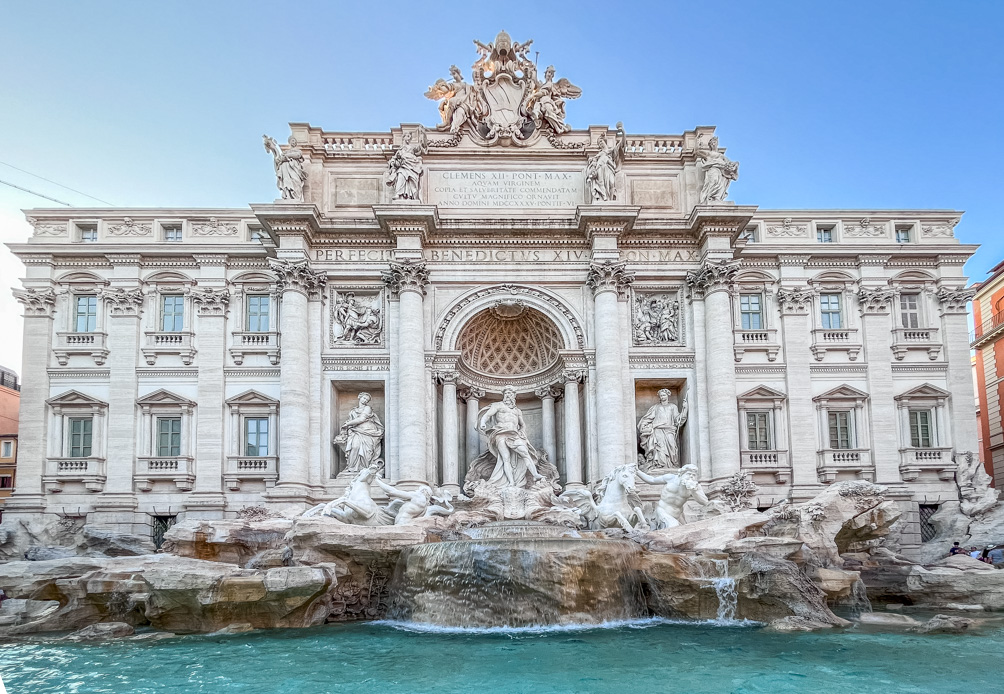
If you’re not interested in covering all the sights given in the app, just go to the iconic spots mentioned below. The distance you’ll have to walk will be about 2.7 km.
Rome Centro Storico Walking Route Map
- Two Sizes (for the best Tiramisu ever!)
- Piazza Navona: Our favourite piazza in Rome—it is so grand!
- Pantheon: The Pantheon is ancient Rome’s best-preserved temple. An engineering masterpiece from AD 125 featuring a massive dome that fills the interior with light. For 1300 years, the dome was the biggest in the world, and it is still the biggest unsupported dome in the world today. Entry is until 6:30 PM, and you will need to book tickets beforehand. See the tips below.
- Gelato at Giolitti: It’s a super old gelateria
- Church of St. Ignatius Loyala: For the beautifully painted ceiling you can see by looking up oe through a mirror. Don’t foget to notice the fake dome!
- Piazza Colonna: The Obelisk here has beautiful intricate carvings (pictured somewhere above in this 3-day Rome itinerary)
- Trevi Fountain (have the Colosseum-shaped popsicle at Lucciano’s near Trevi) and toss a coin into the fountain to ensure your return to Rome.
- Spanish Steps: Nothing much to see but it’s a popular sight in Rome
- Pompi Tiramisu: Another Tiramisu we loved!
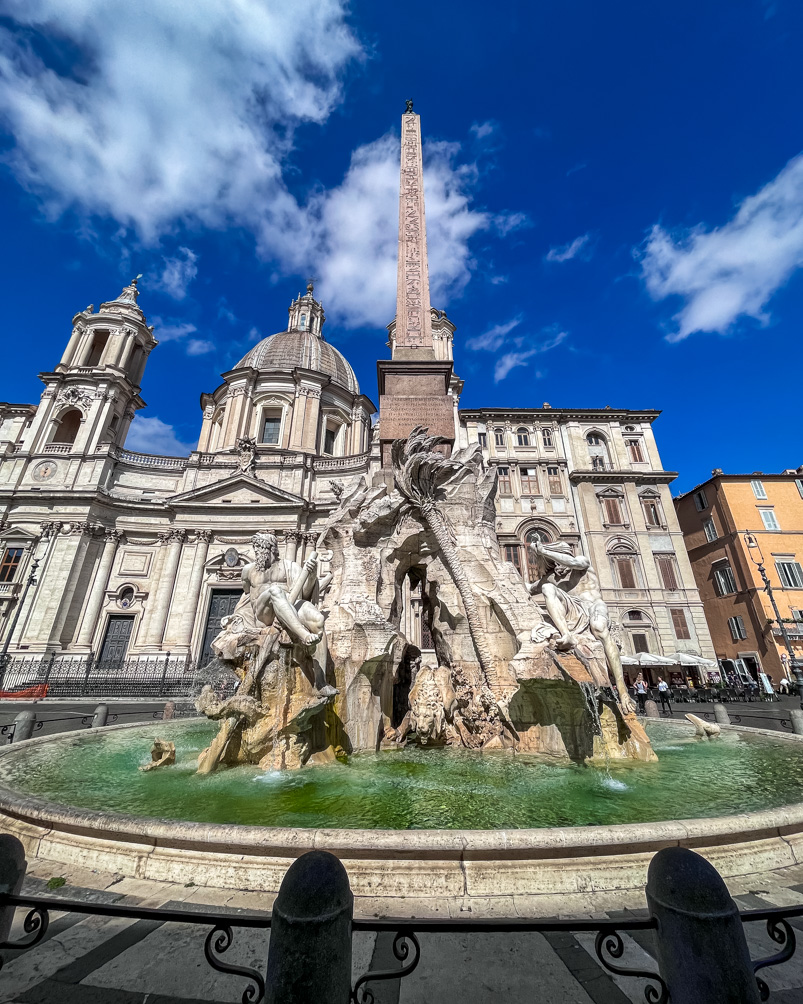
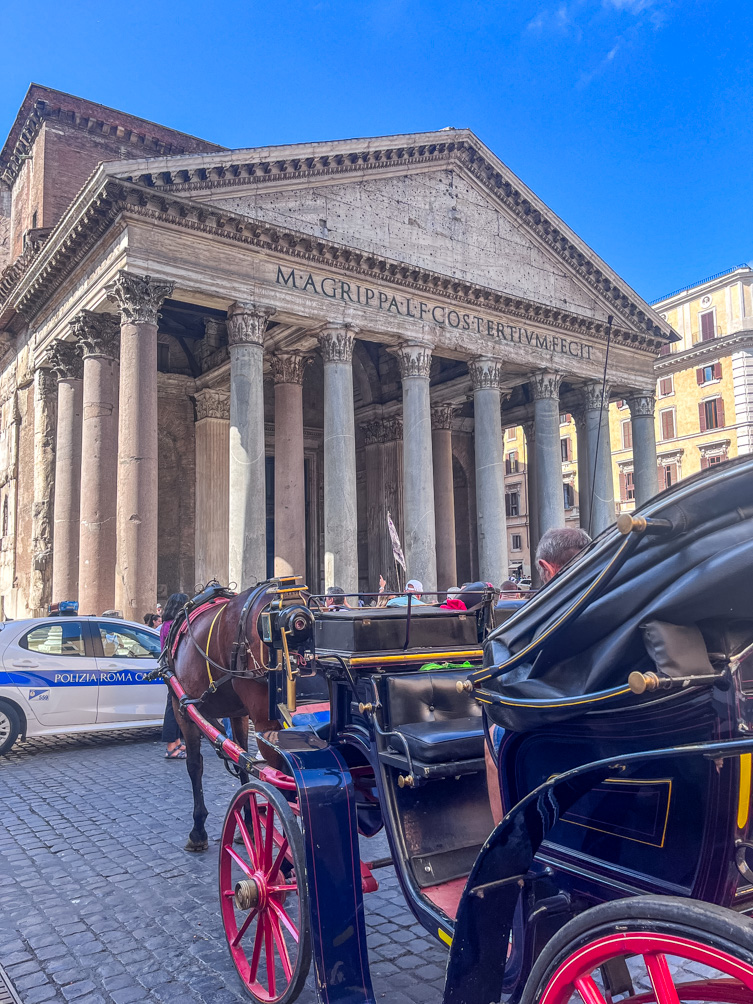
Tips for booking tickets for the Pantheon in Rome
The Pantheon used to have free entrance until July 2023. That’s when we went, and there was a lot of chaos. The lines to purchase the Pantheon tickets even now can be extra long. So it is best to purchase these beforehand, but unfortunately, it is not so straightforward.
- Purchase the ticket from the official website for €5 + 1 (convenience fee). You need to register yourself on the website before the purchase can happen. Two issues can come up. Firstly, not getting the verification email. Secondly, the website not accepting international credit cards. In this case, there is a workaround: select “Other Payment Methods” and choose the PayPal account option. If that also doesn’t work, then go for option 2.
- Purchase a ticket from here. It will cost more, but it will save you the headache of standing in a long queue and deal with an annoying website.
Day 3: Palazzo Colonna and Villa Borghese
Start your day by visiting the Trevi Fountain in the morning if you’d like to see it without the maddening crowds. It is best to visit between 5 and 8 a.m. to appreciate the beauty of the fountain in peace.
Later, head to Palazzo Colonna. However, if you’re not in Rome on a Friday or Saturday, then head to the Basilica di Santa Maria Maggiore. If you’re a superhuman that can make it to both of these spots, why not?
Morning: Palazzo Colonna
Timings: Fridays only for guided tours (English at 10:00 AM) and Saturdays between 9:30 AM and 1:15 PM
Cost: €16.5-26.5 (short itinerary: €16.5 and full itinerary: €26.5 and Guided Tour: 31.5)
Read details and book tickets here.
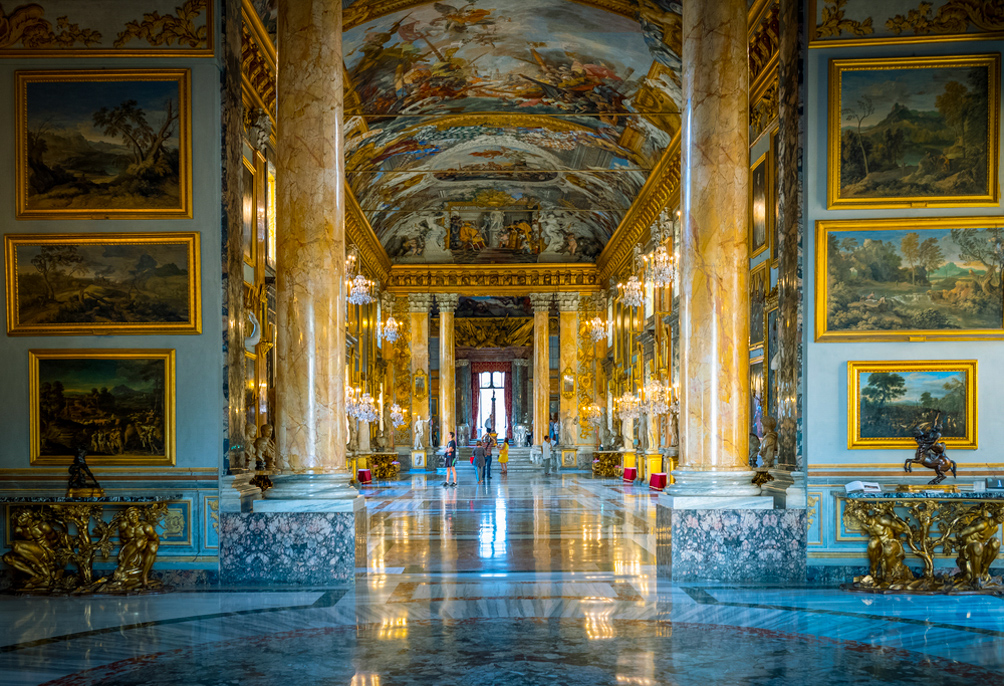
Palazzo Colonna is a masterpiece of Baroque architecture—an opulent palace that was the residence of one of Rome’s most prominent families that counted popes, princesses, and generals amongst their ranks over the centuries. The palace’s undisputed highlight is the awe-inspiring Galleria Colonna, or Great Hall, which is a glittering gallery full of paintings and frescoes.
If you’re not in Rome on Friday or Saturday, then you’ll have no option but to skip this attraction! You can alternately wake up a bit late or add in an attraction you might’ve missed on the previous day.
OR
Morning: Basilica di Santa Maria Maggiore
Timing: 6 AM to 7:45 PM
Entry: Free
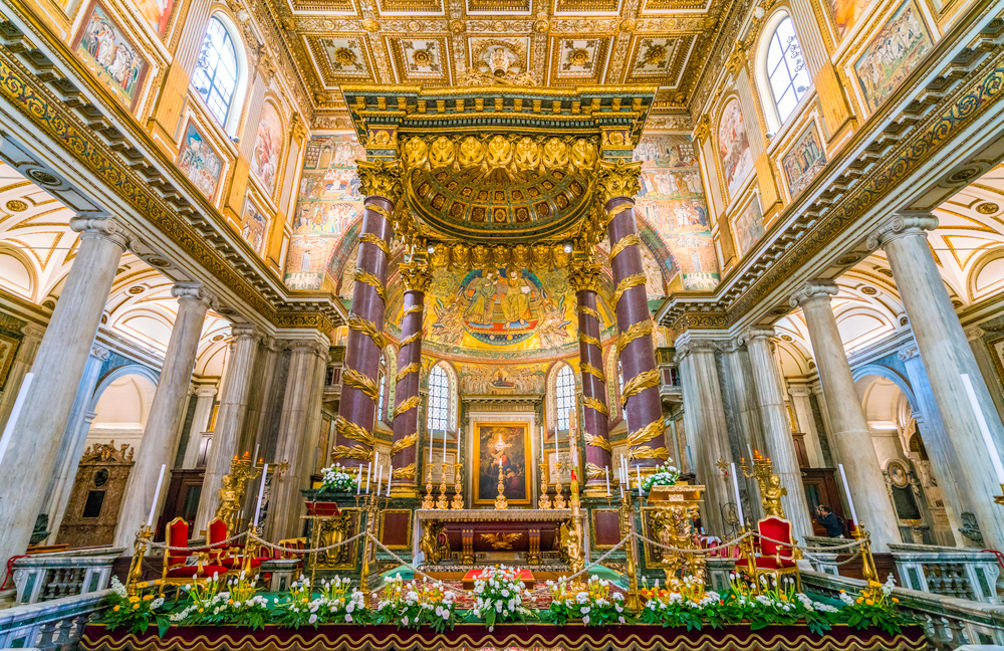
Constructed in the 5th century, the Basilica di Santa Maria Maggiore is one of the four major papal basilicas in Rome that was built after a miraculous snowfall in August. Inside, you will be treated to a visual feast of intricate mosaics and frescoes spanning multiple artistic periods. In addition, the basilica is home to Rome’s largest bell tower and the Sistine Chapel, which was built before its Vatican equivalent!
Afternoon and Evening: Villa Borghese
Timing: 9 a.m. to 7 p.m. in 2-hour slots. The last slot is at 5:45 p.m., is for 1 hour and 15 minutes, and is discounted.
Cost: €13, plus a €2 online reservation commission. Book your ticket here.
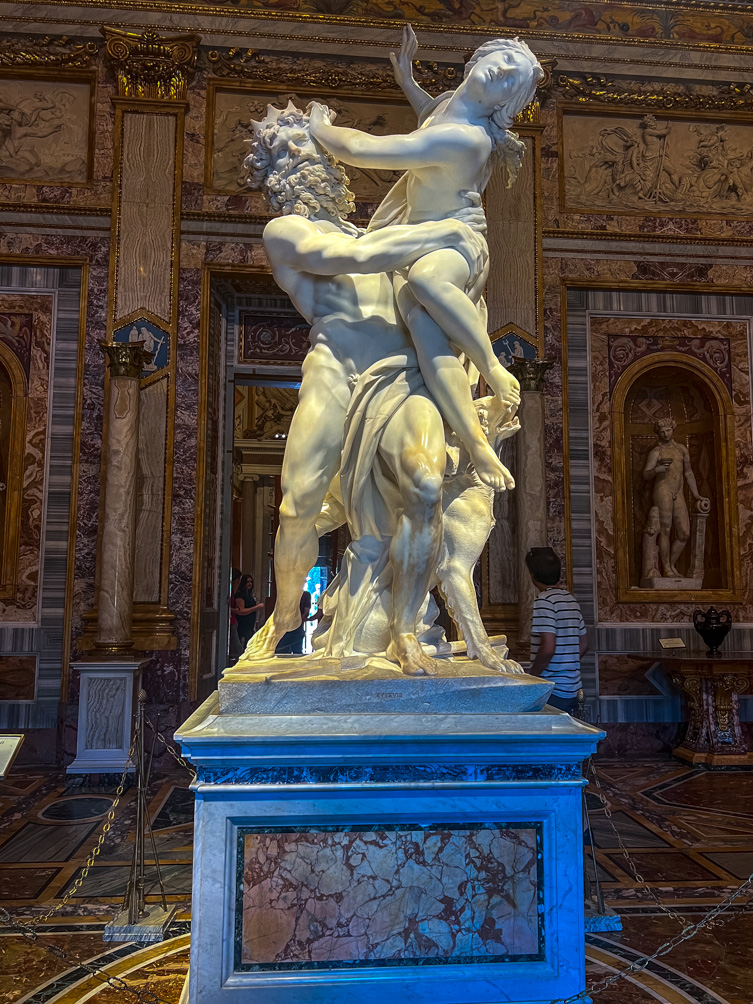
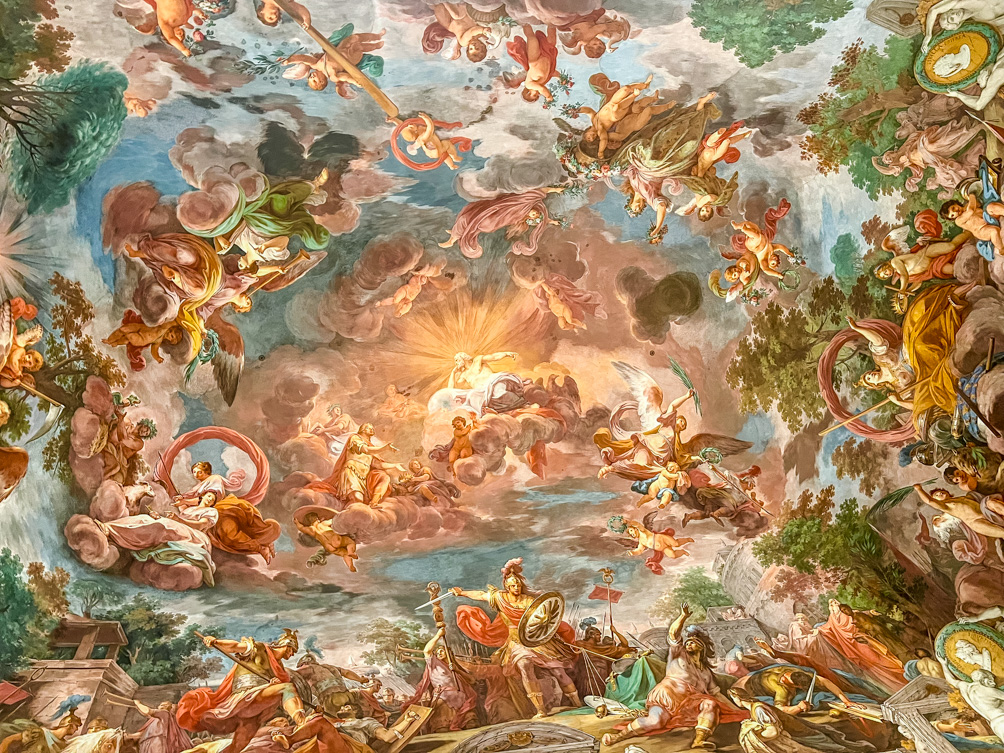
Villa Borghese is somewhere you can spend half a day easily. Explore the 17th-century Borghese Gallery, a villa constructed by a well-known noble family in Rome who were involved in politics and the Church (this family has produced a pope and several cardinals). Even though you have seen so many stunning churches and galleries in Rome, the gallery will still astound you. It houses a treasure trove of art, including works by Bernini, Caravaggio, and Raphael.
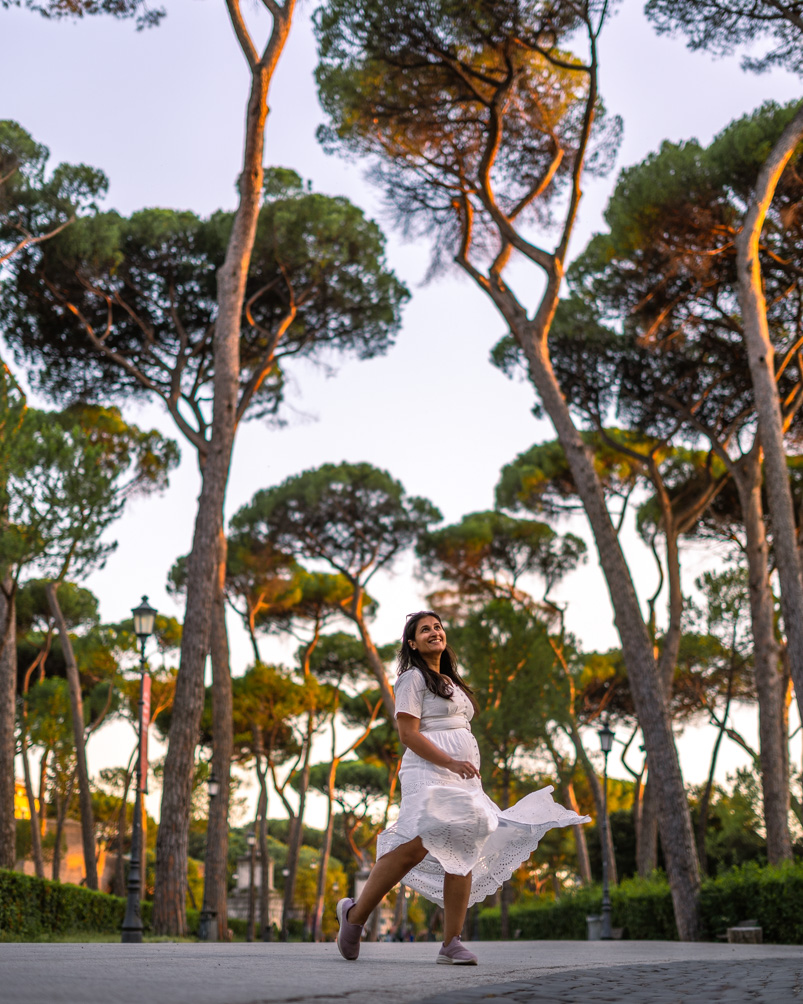
After or before the gallery visit, walk or cycle around its lush manicured gardens (which are free to access) and row a boat for 20 minutes on a serene lake with the backdrop of a temple.
Tip: If you’d like to visit the Borghese Gallery and the park, then I suggest renting a vehicle of some sort at the park entrance because the park is massive. Even getting to the Borghese Gallery from the entrance might be a bit too much for some (I had blisters on my feet from all the walking in Rome and would’ve loved to have a vehicle to see the park). There are plenty of options, like bikes, small golf karts, quad bikes, and Segways.
Dinner
There is a restaurant in Rome that is known to be the birthplace of Alredo pasta. It is called Alfredo alla Scrofa. Head here for dinner!
How to Reach the Rome City from the Airport
Rome has two airports. Leonardo da Vinci-Fiumicino Airport is the largest airport in Italy, hence the most used. It is located more than 34 km from the city centre. The other is Ciampino Airport, which is closer but still 16 km away from Rome. This airport is mainly used for budget airlines.
There are many ways to get to the city centre from the airports, including shuttles, trains, private transfers, and taxis.
Bus
The least expensive way to go from any of these airports to the heart of Rome is to take a shuttle bus to Termini train station, which is the main train station and has access to the metro. These transfers range in price from €6-7, based on the specific airport. These shuttle buses are offered by two companies for both airports.
Buy tickets for a shuttle from Leonardo da Vinci–Fiumicino Airport: SIT Shuttle and Terravision.
Buy tickets for a shuttle from Ciampino Airport: SIT Shuttle and Terravision.
Train
The train only connects the Leonardo da Vinci-Fiumicino Airport with the city and, hence cannot be used for the Ciampino Airport.
You can take one of the two train options from the Leonardo da Vinci-Fiumicino Airport airport to the city.
- The Leonardo Express is a Trenitalia non-stop train connecting Fiumicino Airport with Rome Termini. It takes roughly 30 minutes and leaves the airport every half-hour, or every 15 minutes during peak hours. The train runs between 5:35 a.m. – 11:35 p.m. Tickets cost €14.
- The second option is the regional train called the FL1. It goes to several stations in central Rome, but it does not go to Termini. You can get off at Trastevere, Tuscolana, Ostiense, or Tiburtina stations, depending on where you’re staying. Trains leave every 15 minutes or so, and the cost is about €8. This was the train we took, as our Airbnb was just across Ostiense Station.
It is best to buy the train ticket from the ticket kiosk at the station itself for the lowest prices. However, if this seems like it might be a headache on your first day (it even took us a bit of time to figure out the whole process), then you can also purchase the ticket for Leonardo Express online. After using the train, you might also have to use a bus, metro, taxi, or simply walk to get to your hotel.
3. Private transfer from the airport
If you’d like to reach your hotel directly without any hassle, then you can also book a private transfer. Your driver will wait for you once you exit the airport or the hotel. Some companies charge per adult, while others charge per group.
4. Taxi
Price: €48 from Fiumicino Airport, €30 from Ciampino Airport
Taxis charge a flat fare from the airport to any place within the boundaries of the Aurelian Walls in Rome. Remember to only get a cab from an official taxi stand!
Important!
Before boarding the train, always get your train ticket validated from the smaller ticket machines you will find at the entrance to the train. These are usually green in colour and are quite small and easy to miss, so be on the lookout for them to avoid getting fined! If your ticket is purchased online, then validation is currently not necessary, but this may or may not change in the future, so it is always better to check.
How to Get Around Rome
Rome’s well-functioning public transport system makes getting around easy. Convenient transport to important sites is provided by the city’s network of buses, trams, metros, and trains. Simply use Google Maps to figure out how to get from one place to another, and it should show you all the possible options. Our recommended modes of transport are the bus, metro, and on foot!
Bus: Due to its excellent connection and few walking requirements, the bus was our preferred mode of transportation, especially on weekends when there was no rush Buses on weekdays can be chaotic, so set your expectations accordingly! You can find bus routes and timetables at the bus stops. Most buses run from early morning until midnight, with night buses operating during the remaining hours (if you’re out late, look out for bus stops with a blue owl symbol). We did not download any apps, but you can also download the Roma Bus App to plan your travel routes and stay updated on the go.
Do not forget to validate your ticket on the bus’s front, middle, and rear machines (see the photo below). If you don’t, you could be fined roughly €60.
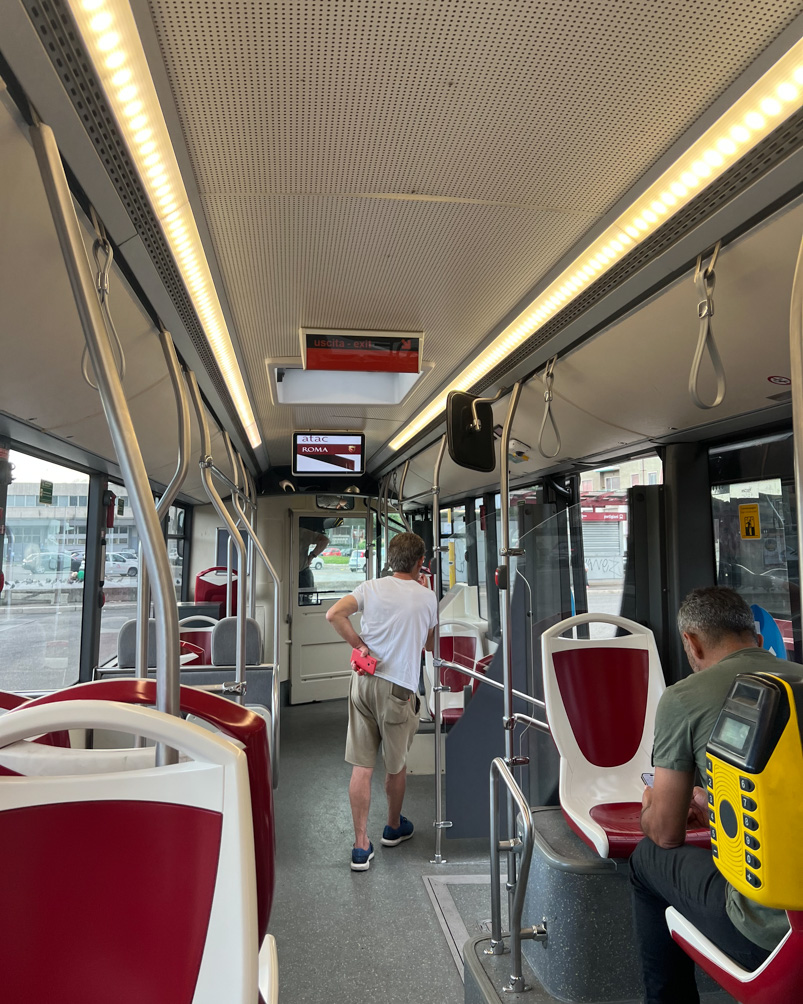
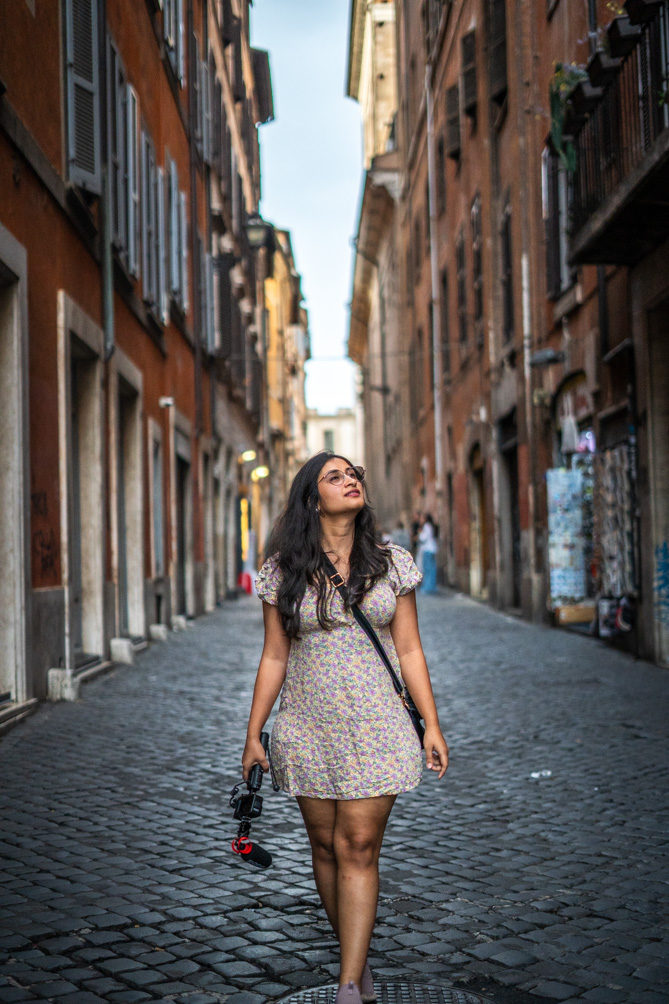
Metro: Obviously, you avoid all the traffic, making this another excellent mode of transportation. The metro runs every day from 5:30 a.m. to 11:30 p.m. and until 01:30 a.m. on Saturdays. However, we didn’t use the metro as much.
On foot: The rest of the time, you’ll be walking on foot, and trust me, this can be amazing. Walking down Rome’s meandering cobblestone lanes reveals many of its enchanted nuances. That being said, let me warn you that you might be walking much more than you’re used to (think 15000–20000 steps a day), and that too on cobblestone streets, so please wear the most comfortable pair of shoes you own. If you’re staying in the city centre, most places will be accessible by foot!
While trams are also available in Rome, you will likely not use them on this Rome itinerary except maybe to travel between Torre Argentina and Trastevere because trams aren’t available in the Centro Storico.
Hop-on, hop-off bus transport is more expensive than regular ATAC transport unless, obviously, you’re getting a tourist card.
E-bikes and electric scooters are two more well-liked modes of transportation. While these can be fun, I would recommend not relying on them throughout your time in Rome, as there are some safety risks as helmets are not provided and traffic in Rome can be crazy. But if you’d like to, we’d recommend Bird and Dott for e-bikes and Lime for electric scooters. Remember that only one person per vehicle is allowed
Tips and Must-Knows for Public Transport
- All public transport (ATAC), including trams, buses, metros (except tourist buses), and some regional trains (Trenitalia 2nd class, Roma-Lido, Rome-Viterbo, and Rome-Giardinetti), are covered by the same ticket. But you can’t use these tickets to travel to the airport!
- Once the ticket is validated, it can be used on multiple modes of ATAC transport within 100 minutes to get to your intended destination.
- On all ATAC transit, children under the age of ten travel free when accompanied by a paid adult.
- You can choose from several different metro or bus tickets:
- BIT Ticket: You may take the tram, bus, and metro for seven days with this 24-euro ticket.
- Roma 24H/48/72H Ticket: This is valid 24, 48, and 72 hours after activation, respectively, costing 7€, 12.5€, and 18€. I highly recommend getting the 72-hour ticket for this 3 days in Rome itinerary.
- CIS Ticket: With this ticket of 24 € you can travel for 7 days on the tram, bus, and metro.
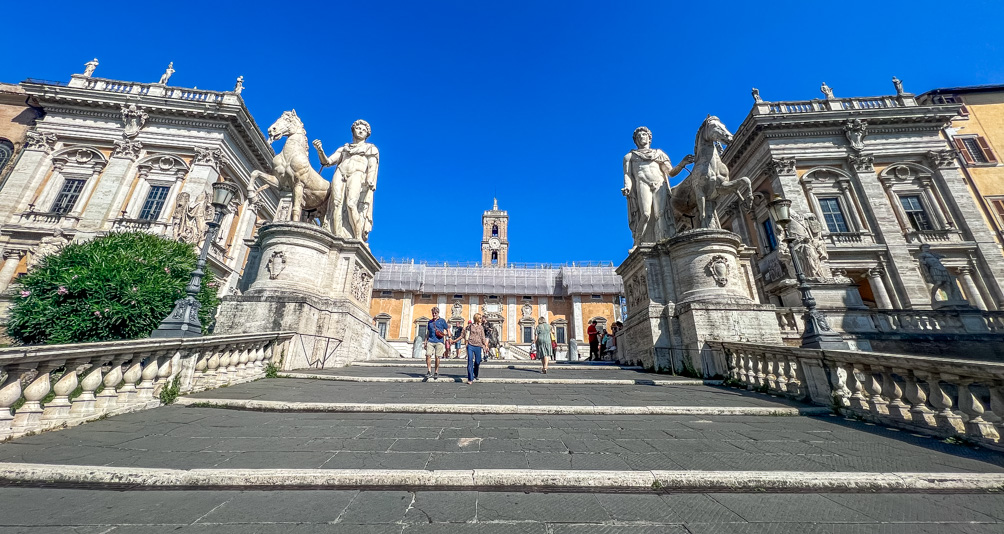
Is it worth buying any Rome City Passes?
The Go City Pass and the Omnia Pass seem to be extremely expensive and not worth it for this itinerary. However, I’m linking them both so you can make an informed decision.
The only pass worth considering for this itinerary is the Roma Pass. Let me list down the benefits per the Roma Pass Website.
- The first 2 tourist sites are included
- Reduced ticket prices for all tourist sites visited thereafter
- Free use of the city’s public transport for the validity period of the card
- Discounts for exhibitions and attractions
- Dedicated booking arrangements for tourist sites
- Free access to toilet services of the P.Stop network
- Valid for museums and public transit for 72 hours following the initial validation.
Does this benefit you?
If you follow this itinerary, then buying the Roma Pass may turn out to be Euro 5 more expensive for you if you enter all the main sights but do not enter the Capitoline Museum or Largo di Torre Argentina. If you enter one or both of the aforementioned sites, then you will save Euro 6.5–7.5 by buying the Roma Pass.
The benefits and savings from the Roma Pass increase as you go to more and more paid sites that are listed in their brochure within the pass validity period.
All in all, I do not think there is any need to buy the Roma Pass if you’re following this itinerary. If you’re adding some other sights to your itinerary that aren’t mentioned below, then I would suggest going through the details of the Roma Pass by yourself to ascertain if you’re going to benefit from it or not.
Other Tips for Visiting Rome
- Secure your access to popular sites by booking tickets in advance, particularly for attractions like the Colosseum, Vatican, and Gallery Borghese. This 3 days in Rome itinerary has the ticketing websites mentioned for easy bookings.
- When dining, venture beyond the tourist hotspots to discover authentic trattorias where locals savour their meals. Do not follow ‘where to eat guides’ guides you find on Instagram unless they are by locals. However, we have provided a few dining options that we enjoyed.
- Beware of the scams. Read more about it here. And always be careful with your belongings, as pickpocketing is a huge issue in Rome.
- We recommend downloading the Rick Steves Audio Europe App for the best free tours possible. Throughout the itinerary, I have mentioned these guides so you’re well aware of where you can use them. Download each guide before you set out for the day, and don’t forget to carry earphones to listen to them.
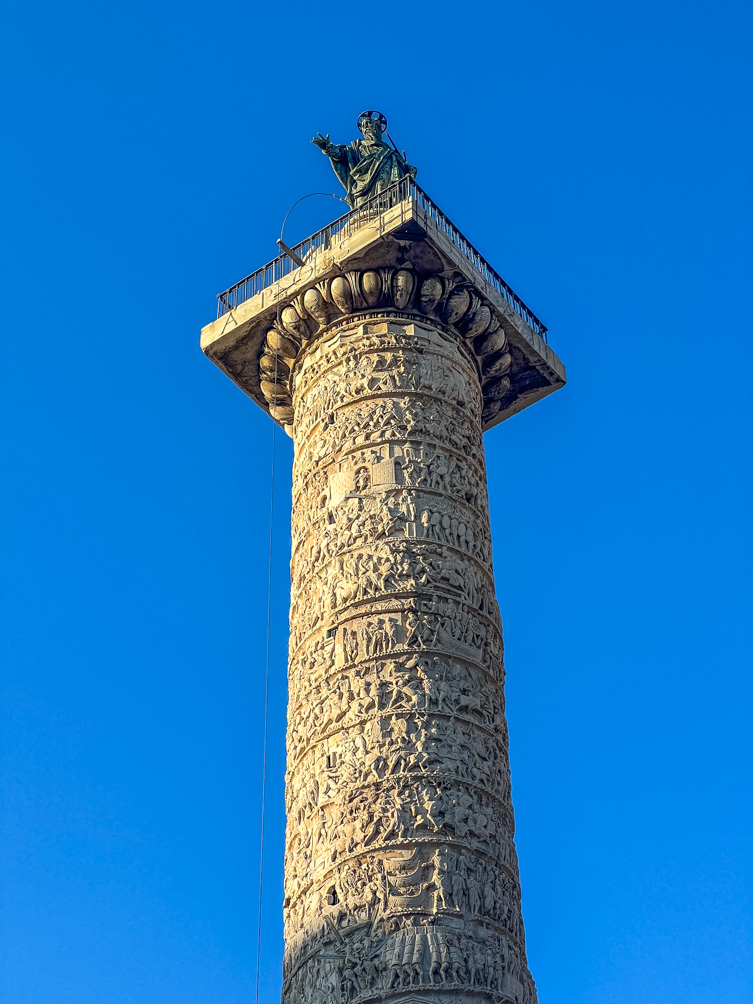
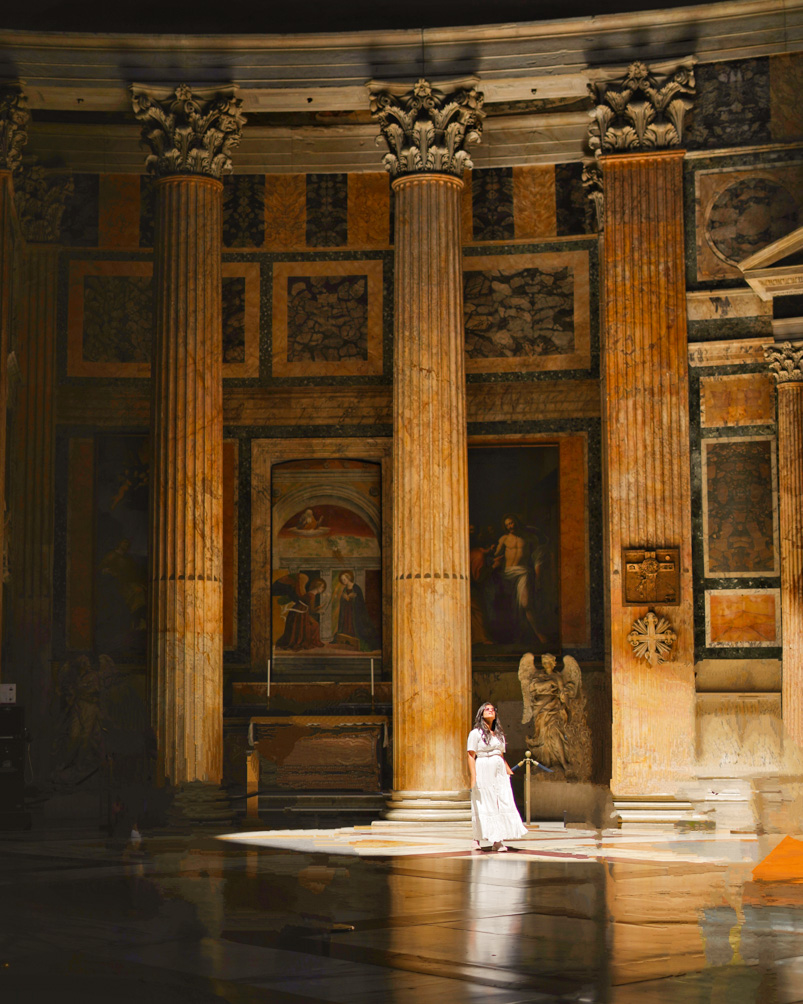
- Remember that the Vatican is closed on Sundays, and Colonna Galleria is only open on Fridays and Saturdays. Switch around the days on your 3 days in Rome accordingly. This itinerary works perfectly if your day 1 is Wednesday or Thursday; otherwise, you may need to switch the days around.
- Rome has multiple attractions that are free on the 1st Sunday of every month: Colosseum, Pantheon, Roman Forum, Capitoline Museums, Borghese Gallery, etc. However, certain locations (like the Borghese Gallery) require reservations; the only way to secure a spot is to give the attraction a call.
- The Vatican Museums are free to visit every last Sunday of the month from 9 a.m. to 2 p.m.
- Remember to cover your knees and shoulders when entering churches; otherwise, you may not be allowed inside
- You will not need to buy drinking water in Rome. Rome is renowned and prides itself on its availability of fresh and clean drinking water. Carry a refillable water bottle and fill it at any of the water fountains in the city. These fountains will have a long nose or spout. You can drink directly from it too by blocking the main nozzle, which will direct the water upwards through a secondary hole on the spout. If the water is not drinkable, then a signboard will mention ‘aqua non potabile’
That’s all for the 3 days in Rome itinerary. I hope you found this blog post helpful in planning your trip. Do let me know what you found most useful, and leave your questions in the comments sections below. I would love to help!
Other Reads from Italy
10 Days in Italy Itinerary
2-Day Florence Itinerary
A Day Trip to Lake Como from Milan
Cinque Terre in One Day
How to Visit Saturnia Hot Springs in Tuscany
This blog post, ‘3 Days in Rome Itinerary’, has affiliate links that enable us to earn a small commission when you make a purchase, with no extra cost to you. We only recommend products and activities we like and those that might interest you. If you like any suggested product, do buy from the given links.
